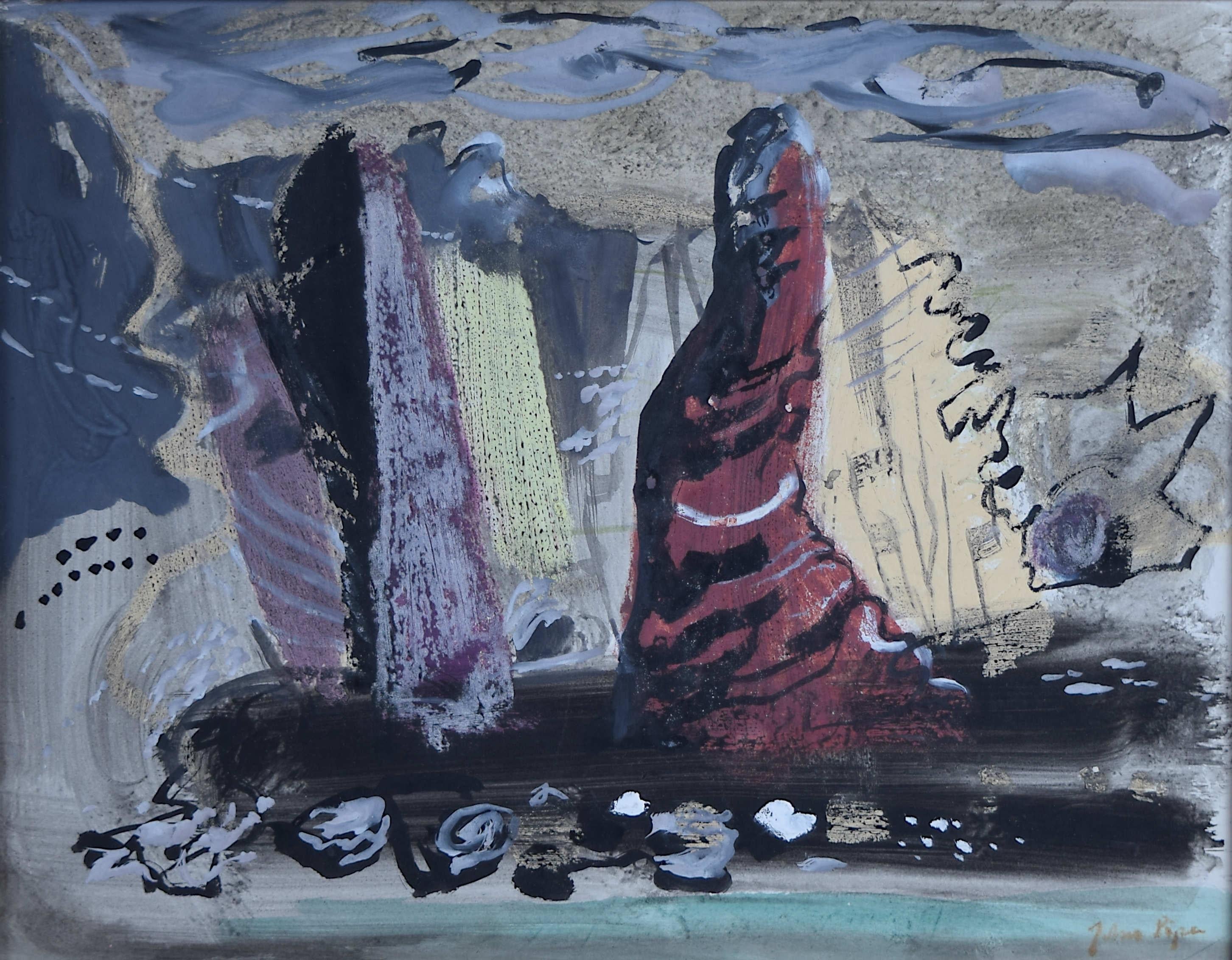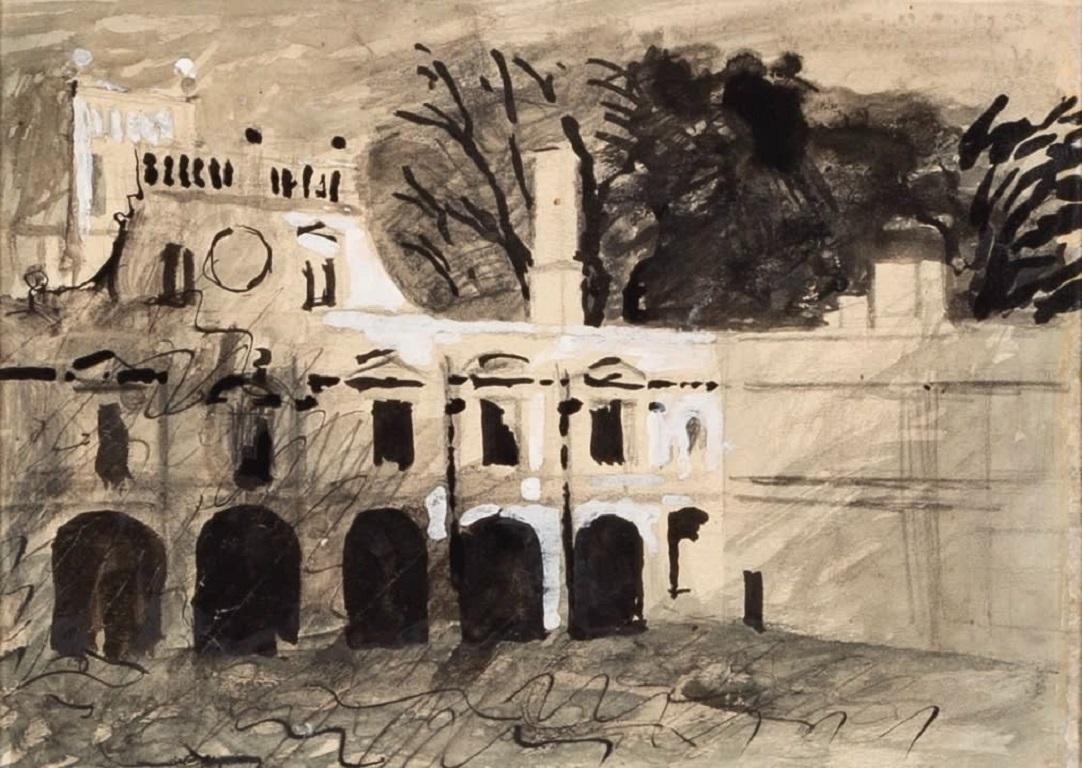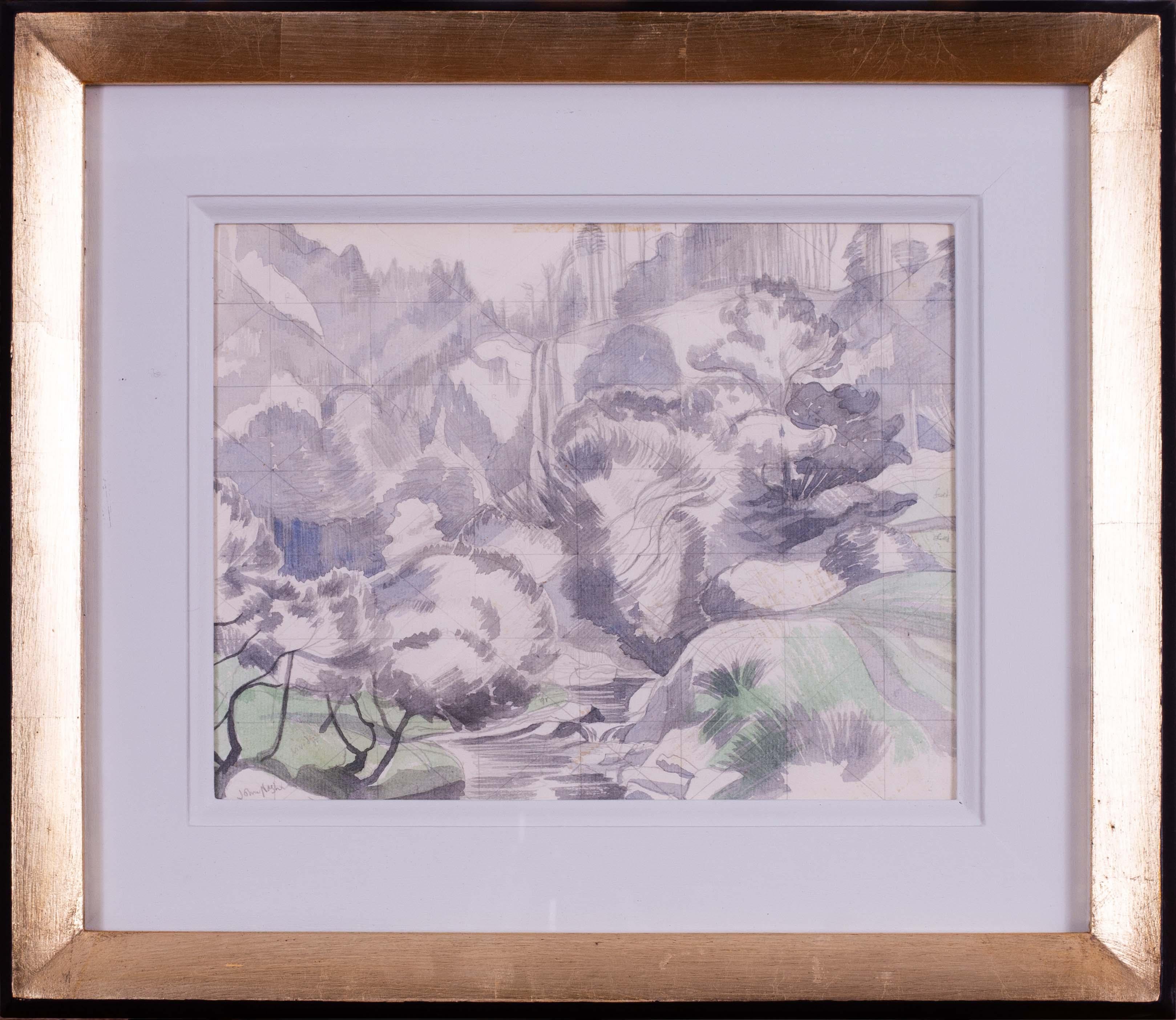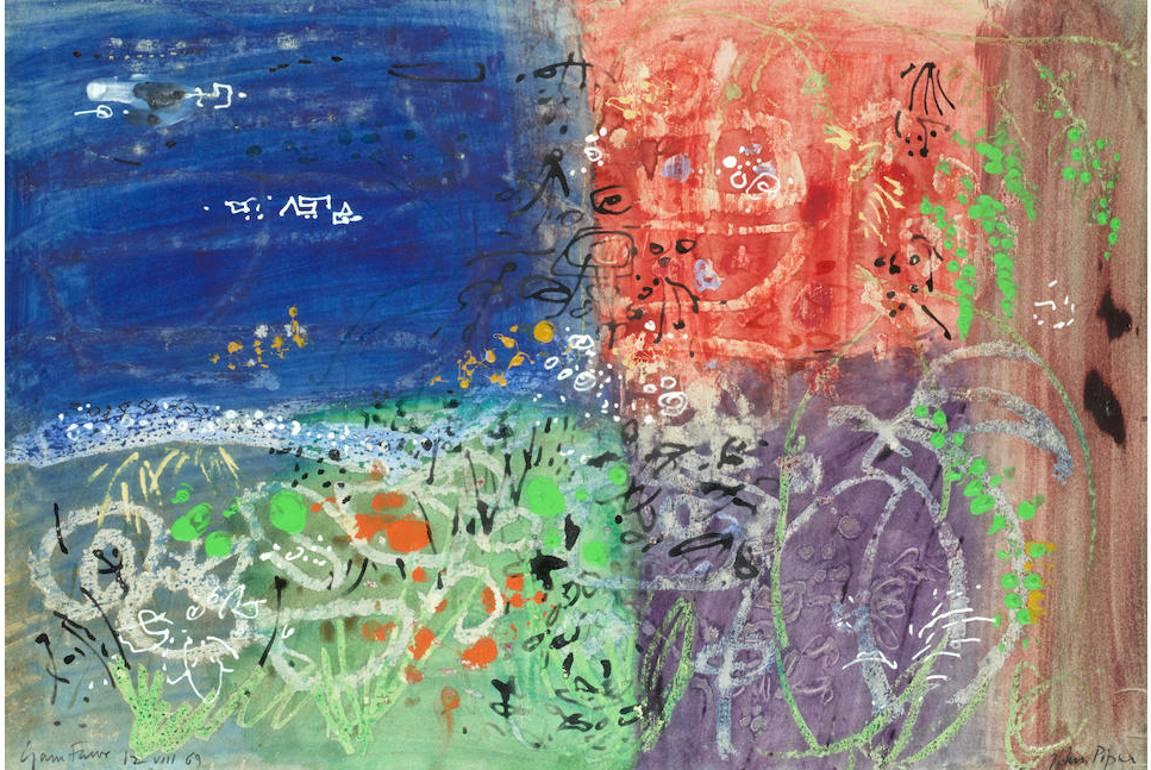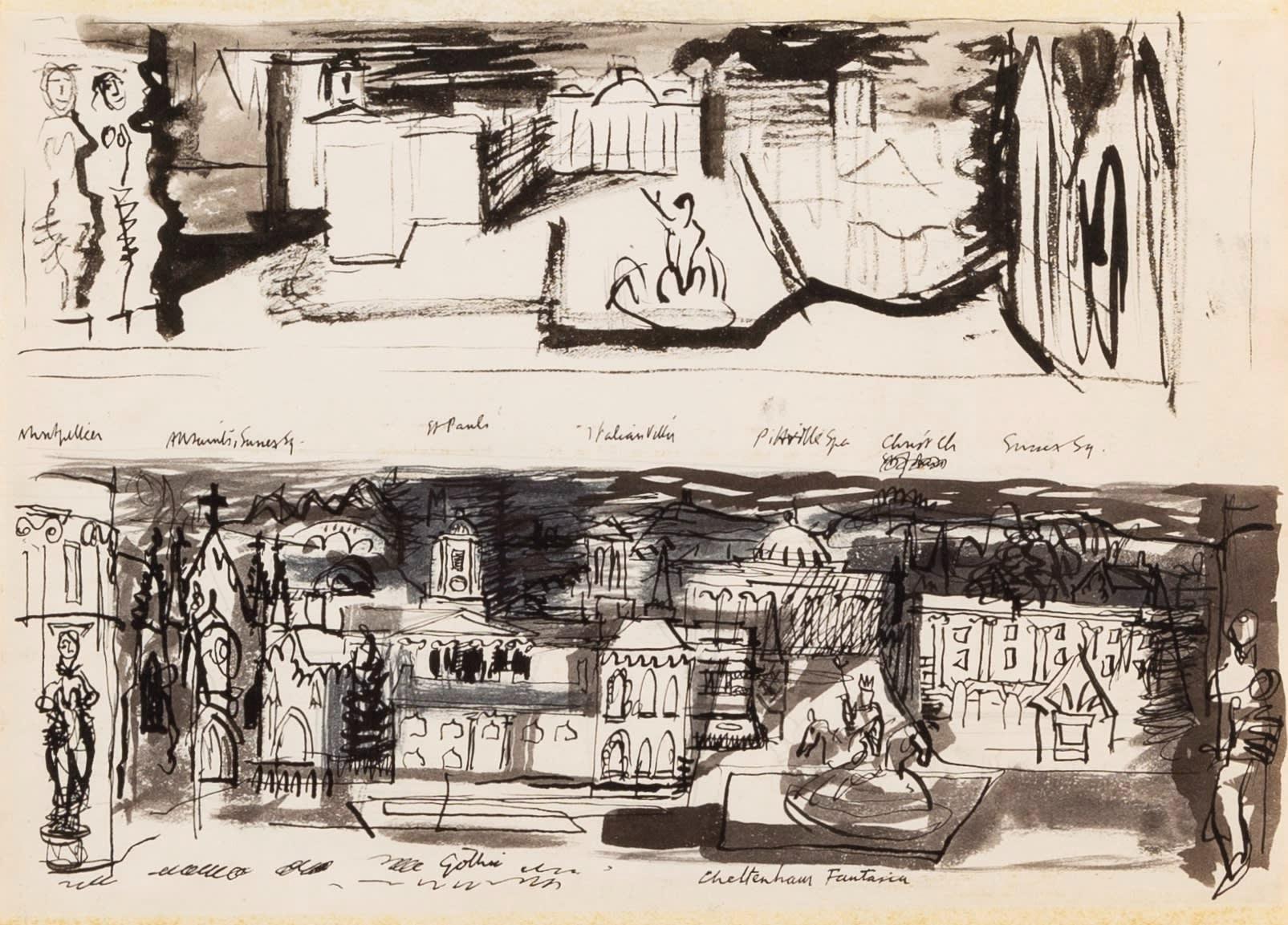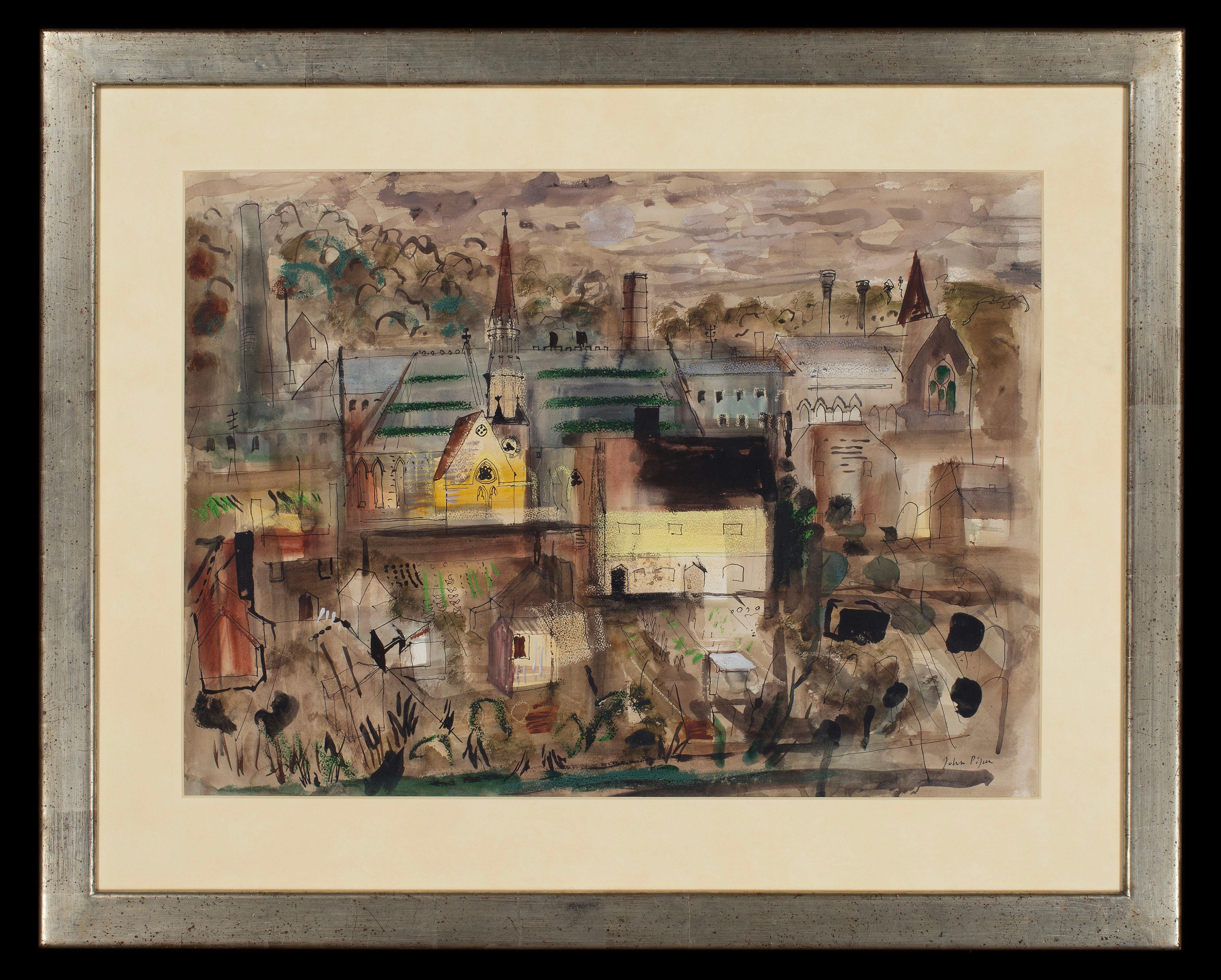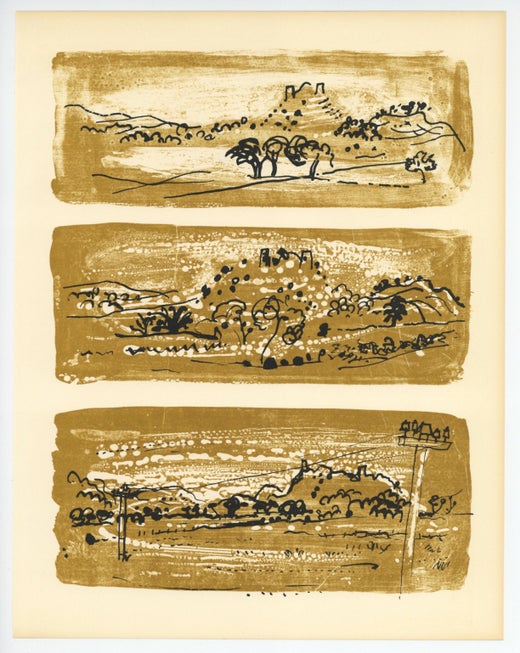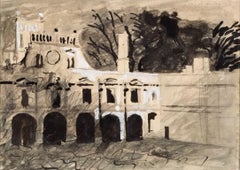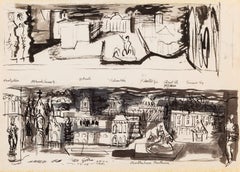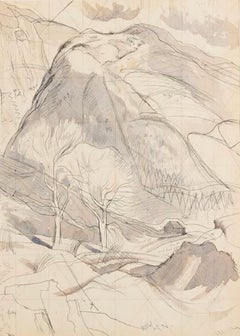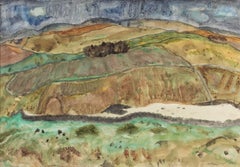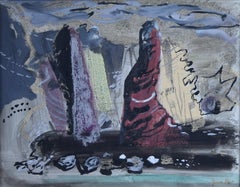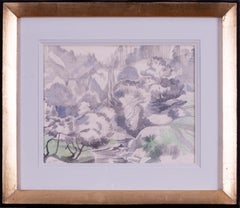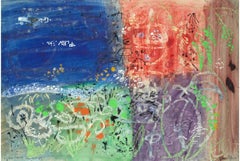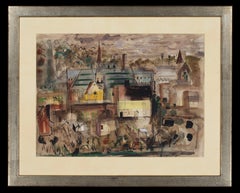Items Similar to Foot of Pistyll Rhaeadr, Ink and Wash Painting by John Piper, circa 1939-1941
Want more images or videos?
Request additional images or videos from the seller
1 of 3
John PiperFoot of Pistyll Rhaeadr, Ink and Wash Painting by John Piper, circa 1939-19411939-1941
1939-1941
Price Upon Request
Price Upon Request
Price Upon Request
Price Upon Request
Price Upon Request
Price Upon Request
Price Upon Request
Price Upon Request
Price Upon Request
Price Upon Request
About the Item
Foot of Pistyll Rhaeadr, Ink and Wash Painting by John Piper, circa 1939-1941
Additional information:
Medium: Ink and wash
12.5 x 17.7 cm
4 7/8 x 7 in
Titled under the mount
John Piper was a painter of architecture, landscape and abstract compositions, a designer for the theatre and of stained-glass windows, and a writer on the arts.
Piper was born in 1903 in Epsom, Surrey, the son of a solicitor. Throughout his childhood, he regularly visited Italy, and by 1924 he had published a book of poems and his own illustrations. He worked in his father's office in Westminster until 1928 when he began studying at the Richmond and Kingston Schools of Art. This was followed by two years study at the Royal College of Art. In 1927 he exhibited with David Birch at the Arlington gallery, and in 1931 with Clarice Moffat, P. F. Millard, and his first wife Eileen Holding at the Mansard Gallery in the Heal's store. From 1928 Piper was also contributing towards the Nation.
Piper was a member of the London Group from 1933, and of the Seven and Five Society from 1934 to 1935, exhibiting alongside Henry Moore, Ivon Hitchens, Cedric Morris, Ben and Winifred Nicholson, Christopher Wood, Barbara Hepworth and David Jones. That same year he married Myfanwy Evans, the writer, and for the next two years assisted her on Axis - a Quarterly Review of Contemporary ‘Abstract’ Painting and Sculpture. He began writing for the Architectural Review in 1938, the same year in which he published the first of his popular guidebooks.
In 1938 Piper held his first solo exhibition at the London Gallery where he displayed a collection of his collages and drawings. His early work consisted primarily of landscapes, inspired by his time spent on the south coast with Ben Nicholson, Henry Moore and Ivon Hitchens. His time with these artists and a visit to Paris in 1933, had turned Piper to abstraction. He put these lessons behind him around the time of the onset of the Second World War and focused his energies on representing the British landscape, particularly its architectural subjects. It was around 1939 that Piper first met Sir Osbert Sitwell, who became a great supporter of the artist.
He designed the stage for Stephen Spender's Trial of a Judge in 1938, for the ballets The Quest in 1943 and Job in 1948, and for six operas by Benjamin Britten. Piper was an Official War Artist from 1940 to '42, recording sites which were threatened with bombing such as Windsor Castle, and those which suffered bombing in Coventry, Bath, Bristol and London.
His first international exhibition was at the Buchholz Gallery, New York, in 1948, and he was commissioned to paint decorations for the British Embassy in Rio de Janeiro that same year. International exhibitions followed at Curt Valentin Gallery, New York (1955), Kunstzall Magdalene Sothmann, Amsterdam (1956), Durlacher's, NY (1957), and Gallery Kasahara, Japan (1976).
In 1951 he supervised the design of the Battersea Pleasure Gardens with Osbert Lancaster. He was also commissioned to design the windows for the Chapel at Oundle School in 1954, and the baptistery of the new Coventry Cathedral in 1958.
Between 1963 and '64, Piper produced 'A Retrospect of Churches' in collaboration with his friend John Betjeman, with whom the artist has visited many of the subject churches. Betjeman praised Piper for his love of all architecture: 'He responds to Renaissance monuments ... the originality and sense of scale of the great Victorian architects ... [and] Gothic conventions'.
His work is included in numerous public collections, as well as Deutsche Bank. The inclusion of his work in the Tate's Walk Through British Art was commented on by Alexandra Harris, “There are things that British artists tend to do wonderfully well ... There’s a certain complex, understated colouring that recurs. John Piper thought it was partly about the weather: British eyes are accustomed to seeing things in a certain light. This is simple but makes sense. The great Spanish painters specialise in black shadows and intense light. The British are better at fathoming a thousand varieties of grey and green.”
- Creator:John Piper (1903-1992, British)
- Creation Year:1939-1941
- Dimensions:Height: 4.88 in (12.4 cm)Width: 7 in (17.78 cm)
- Medium:
- Period:
- Condition:
- Gallery Location:Kingsclere, GB
- Reference Number:1stDibs: LU2718214575582
John Piper
Born in Epsom, John Egerton Christmas Piper studied at Richmond School of Art and the Royal College of Art from 1926-8. In the mid 1930a, after a visit to Paris, he turned to abstraction. He became a member of the London Group in 1933 and the ‘Seven and Five’ group in 1934-5. During this period he became friends with Oliver Simon of the Curwen Press and his interest in lithography and print making grew. During the Second World War, Piper was appointed as an official war artist recording the effects of the blitz on Britain’s buildings. After the war, he became a Trustee of the Tate and National Galleries and in 1959 he became a member of the Royal Fine Art Commission. Piper is best known for his extensive studies of British architecture and landscape in oil, watercolour and print, and for his photography, stained glass, ceramics, fabric design, murals, stage sets and costume design. His work is held in many Museums and Galleries.
About the Seller
No Reviews Yet
Vetted Professional Seller
Every seller passes strict standards for authenticity and reliability
Established in 2010
1stDibs seller since 2024
43 sales on 1stDibs
Typical response time: 8 hours
- ShippingRetrieving quote...Shipping from: Kingsclere, United Kingdom
- Return Policy
Authenticity Guarantee
In the unlikely event there’s an issue with an item’s authenticity, contact us within 1 year for a full refund. DetailsMoney-Back Guarantee
If your item is not as described, is damaged in transit, or does not arrive, contact us within 7 days for a full refund. Details24-Hour Cancellation
You have a 24-hour grace period in which to reconsider your purchase, with no questions asked.Vetted Professional Sellers
Our world-class sellers must adhere to strict standards for service and quality, maintaining the integrity of our listings.Price-Match Guarantee
If you find that a seller listed the same item for a lower price elsewhere, we’ll match it.Trusted Global Delivery
Our best-in-class carrier network provides specialized shipping options worldwide, including custom delivery.More From This Seller
View AllKirby Hall, Northamptonshire, Gouache with Ink and Wash Painting, 1940-42 circa
By John Piper
Located in Kingsclere, GB
Kirby Hall, Northamptonshire, Gouache with Ink and Wash Painting, 1940-42 circa
Additional information:
Medium: Gouache with ink and wash
15.2 x 18.5 cm
6 x 7 1/4 in
As part of an eight-page pamphlet for The Colour of English Country Houses in 1944, Piper included a lovely auto-lithograph of Kirby Hall in Northamptonshire. This work was most likely sketched on the occasion of his visit to the Hall at this time and is of a slightly different angle. It is a working version of the cover of C Aspinall-Oglander's 'Admiral’s Widow’, 1942 (Hogarth Press). The print is cat. no.51.\\\
Piper gives a lovely description of this Elizabethan country house in the introduction to the pamphlet as follows: ‘A yellow stone house of the seventeenth century, in rolling green hunting-country. It gleams in the sun, forms a warm eye-catcher in dull weather and glimmers whitely in moonlight. It is another ruin, partly roofless, and has recently taken over by the Office of Works to be preserved as a show-place.’ (John Piper). Here, Piper, painting at night in the light of the moon, depicts the north front from the inner courtyard, capturing the brilliance of the moonlit night as it dances over the ruins making it in Piper’s own words ‘glimmer whitely’ whilst the dramatic shadows darken the archways and windows.
John Piper was a painter of architecture, landscape and abstract compositions, a designer for the theatre and of stained-glass windows, and a writer on the arts.
Piper was born in 1903 in Epsom, Surrey, the son of a solicitor. Throughout his childhood, he regularly visited Italy, and by 1924 he had published a book of poems and his own illustrations. He worked in his father's office in Westminster until 1928 when he began studying at the Richmond and Kingston Schools of Art. This was followed by two years study at the Royal College of Art. In 1927 he exhibited with David Birch at the Arlington gallery, and in 1931 with Clarice Moffat, P. F. Millard, and his first wife Eileen Holding...
Category
20th Century Abstract Paintings
Materials
Gouache
Cheltenham (Fantasia/Panorama), Pen and Ink Painting by John Piper, 1939 circa
By John Piper
Located in Kingsclere, GB
Cheltenham (Fantasia/Panorama), Pen and Ink Painting by John Piper, 1939 circa
Additional information:
Medium: Pen and ink
19 x 26.5 cm
7 1/2 x 10 3/8 in
Inscribed extensively
The upper image closely resembles a 1940 painting, Cheltenham Fantasia, which was sold to a Mr Anderson at the Leicester Galleries in March of that year. The lower image is a study for Piper's 1940 Curwen Press auto-lithograph 'Cheltenham', produced while he was also working on illustrations for the Shell and BP Shilling Guide to Gloucestershire (1939; not used in the project). Betjeman, then head of the project, also used the image to illustrate his article "Book Illustration Can Colour a Whole Town or City" in 'Signature' in 1940. The Cheltenham design is covered and reproduced in Hugh Fowler-Wright's book on Piper.
John Piper was a painter of architecture, landscape and abstract compositions, a designer for the theatre and of stained-glass windows, and a writer on the arts.
Piper was born in 1903 in Epsom, Surrey, the son of a solicitor. Throughout his childhood, he regularly visited Italy, and by 1924 he had published a book of poems and his own illustrations. He worked in his father's office in Westminster until 1928 when he began studying at the Richmond and Kingston Schools of Art. This was followed by two years study at the Royal College of Art. In 1927 he exhibited with David Birch at the Arlington gallery, and in 1931 with Clarice Moffat, P. F. Millard, and his first wife Eileen Holding...
Category
20th Century Abstract Paintings
Materials
Ink
Mountain Landscape, Pen and Ink Drawing by John Nash, 1950s, Double-sided
By John Nash
Located in Kingsclere, GB
Mountain Landscape, Pen and Ink Painting by John Nash 1893-1977, circa 1950
Additional information:
Medium: Pen and ink, with another pen and ink with watercolour verso
29 x 21 cm
1...
Category
20th Century Landscape Paintings
Materials
Pen
On the Meldons Road, Watercolour Painting by William George Gillies, circa 1940s
Located in Kingsclere, GB
On the Meldons Road, Watercolour Painting by William George Gillies, circa 1940s
Additional information:
Medium: Watercolour
41.5 x 59 cm
16 3/8 x 23 1/4 in
Signed
William George G...
Category
20th Century Landscape Drawings and Watercolors
Materials
Watercolor
Pastoral Landscape, Gouache and Watercolour Painting by Alan Reynolds, 1953
By Alan Reynolds
Located in Kingsclere, GB
Pastoral Landscape, Gouache and Watercolour Painting by Alan Reynolds, 1953
Additional information:
Medium: Gouache and watercolour
19.5 x 27.5 cm
7 5/8...
Category
20th Century Abstract Drawings and Watercolors
Materials
Gouache
Italian Scene, Pen and Ink with Wash Painting by Reginald Brill, 1950s circa
By Reginald Brill
Located in Kingsclere, GB
Italian Scene, Pen and Ink with Wash Painting by Reginald Brill, 1950s circa
Additional information:
Medium: Pen and ink with wash
33 x 48.3 cm
13 x 19 in
Reginald " Reggie" Brill was a versastile 20th century artist and teacher.
Brill was born in London in 1902 and spent his early childhood there and in Yorkshire. By the time of the First World War, at the age of 13, he was living in lodgings in London, working in a City office and attending St Martins School of Art in the evenings. Considering his lack of education, winning a scholarship to The Slade (now part of University College London) in 1921 where he studied under Henry Tonks for three years, was a huge achievement.
On leaving The Slade he found patronage in Lincolnshire, but by the time of the General Strike (1926) he had returned to London and was working on Lansbury's Labour Weekly. He married Rosalie, also an artist, and in 1927 won the Prix de Rome in Decorative Painting. Following two years at The British School in Rome, Brill went to teach at Blackheath School of Art. During 1930 he spent three months painting in Egypt and it was there that he met Col. T G Gayer-Anderson, one of the twin brothers who were to bequeath The Little Hall in Lavenham as a hostel for art students. It was there that Brill retired to act as warden, thus continuing his nurturing of art students until his death in 1972.
Brill took up his appointment at The School of Art, Kingston upon Thames in January 1934. It was situated in the Technical Institute (Kingston Hall Road) and Brill found it bohemian and disorganised. He proceeded to inject enthusiasm, order and discipline. Within 5 years of his appointment a purpose-built School of Art was opened in Knights Park. It remained open throughout the war and by 1945 there was a waiting list for places. Under the skilled and totally dedicated direction of Brill, Kingston School of Art became established with national reputation for excellence. In 1961 Sir Charles Wheeler opened the new building at Knights Park. Costing £100,000, this more than doubled the size of the Art School.
Brill, was a well-known figure in Kingston. His eloquence made him popular as a guest speaker and his promotion of Art and Design stretched well beyond the doors of Knights Park. Apart from establishing two of the main buildings which makeup what is now known as the Faculty of Design, one of the most visible local contributions he made was the setting up of a topographical collection of paintings depicting Kingston, which has since become known as The Brill Collection at Kingston Museum. Brill gained huge respect and admiration from the hundreds of pupils who studied at Kingston during his 30-year leadership.
He published two books, Modern Painting 1946 and Art as a Career 1962, both bearing a strong educational angle. He regularly exhibited along with leading artists of his era at The Royal Academy, both his paintings and his acutely observed drawings. All the while he was a prolific artist, although reading his diaries, intensely self-critical. His perfectionism, acute powers of observation and relentless research can be seen in his drawings, which via the media and methods he explored throughout his life reflect mid 20th century British Art at its most typical. His major series of work, known as 'The Martyrdom of Man', was carried on in parallel to his career as a teacher. These paintings reflect his care for fellow man and depict people at work, e.g., The Operation, The Jury, Linemen, Waiting Room and Rest, which recently sold at Sotheby’s and was specially restored for The Brill Retrospective. His smaller works also play with the theme of everyday events and communication amongst people, such as The Bull Ring and Market Place paintings.
Brill's name is associated particularly with human figure compositions, but he also worked on landscapes, portraits and details of plants, animals, interiors etc. As one would expect he moved from one media to another, and his unusual hand painted and cut paper mosaics...
Category
20th Century Landscape Paintings
Materials
Pen
You May Also Like
John Piper Bullslaughter Bay c. 1955 Pembrokeshire abstract watercolour painting
By John Piper
Located in London, GB
John Piper (1903-1992)
Bullslaughter Bay
Watercolour, gouache and pastel on paper
27.5 x 35.5cm
John Piper CH was an English painter, printmaker, and designer of stained-glass windo...
Category
1950s Abstract Landscape Drawings and Watercolors
Materials
Pastel, Watercolor, Gouache
John Northcote Nash watercolour of The Falls near Denbigh, North Wales
Located in Petworth, West Sussex
John Northcote Nash CBE RA (British, 1893–1977)
The Falls near Denbigh
Pencil and watercolour with squaring
Signed lower left: John Nash
8.375 x 10.875 in. (21.5 x 27.5 cm)
A finely...
Category
20th Century Modern Landscape Drawings and Watercolors
Materials
Watercolor, Pencil
John Piper Garn Fawr watercolour and gouache painting
By John Piper CH
Located in London, GB
John Piper C.H. (1903-1992)
Garn Fawr (1969)
Watercolour and gouache on paper
37 x 54 cm
Titled and dated lower left ‘Garn Fawr 12 VIII 69′; signed lower right.
It was Piper's wife...
Category
1960s Modern Landscape Drawings and Watercolors
Materials
Watercolor, Gouache
Coalport Shropshire, 1957
By John Piper CH
Located in Eversholt, Bedfordshire
JOHN PIPER (1903-1992)
COALPORT SHROPSHIRE, 1957
Signed lower right
57x78cm
PROVENANCE :
Private Collection
Paisnel Gallery
Private Collection
Comprehensive cataloguing available on ...
Category
1950s Abstract Landscape Paintings
Materials
Watercolor, Gouache
Price Upon Request
A Pembrokeshire Landscape
By John Piper CH
Located in Belgravia, London, London
Mixed media
Paper size: 14 x 21 inches
Framed size: 28.25 x 35 inches
Signed lower right
Category
20th Century Abstract Abstract Drawings and Watercolors
Materials
Paper, Mixed Media, Watercolor
"Dryslwyn Castle" original lithograph
By John Piper
Located in Henderson, NV
Medium: original lithograph. Printed in 1955 and published in New York by Curt Valentin. Sheet size: 12 1/4 x 9 1/2 inches (312 x 244 mm). Not signed.
Category
1950s Prints and Multiples
Materials
Lithograph
